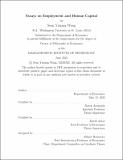Essays on Employment and Human Capital
Author(s)
Wang, Sean Yixiang
DownloadThesis PDF (2.803Mb)
Advisor
Acemoglu, Daron
Autor, David
Terms of use
Metadata
Show full item recordAbstract
This thesis examines how economic forces shape the nature of employment and the development of human capital. Each of the three chapters in the thesis brings economic theory and causal inference to administrative data to better understand the mechanisms that ultimately determine people's livelihoods. Collectively, the chapters emphasize how imperfect markets and institutions have the powerful potential to either reduce or exacerbate existing inequalities.
The first chapter identifies the effects of firms on the career advancement of blue-collar workers and interprets these effects through the mechanism of employer learning. I use administrative data on the universe of Brazilian formal employment to study vertical promotions from production jobs to supervisory jobs, which are an important source of wage growth for most young workers. By comparing workers around job-to-job transitions, I show that differences in average firm promotion rates reflect persistent differences in the effects of firms on workers. Workers who move to a high promotion firm become substantially more likely than other job movers to be promoted, but they are even more likely to leave formal employment altogether. Correspondingly, their average long-term wage gains are negligible. I explain these effects using a model where firms differ in the rate they learn about the abilities of employed workers. High learning firms improve the efficiency of matching between workers and jobs, but these firms also exacerbate the adverse selection of unemployed workers and increase occupational wage inequality. By quantifying the parameters of the model using my estimated effects, I show that skill misallocation remains high and ex-post market power for employers can be large.
The second chapter, written jointly with Samuel Young, studies the effect of private-sector unionization on establishment employment and survival. Specifically, we analyze National Labor Relations Board (NLRB) union elections from 1981 to 2005 using administrative Census data on the universe of establishments in the U.S. Our research design combines difference-in-differences and regression discontinuity extrapolation methods to estimate treatment effects including elections that win by larger margins of support. We show that unionization decreases an establishment's employment and likelihood of survival. We hypothesize that two reasons for these effects are firms' ability to avoid dealing with new unions and managers' opposition to unions. We test this hypothesis for unionization in manufacturing, the largest sector where we find substantial negative effects. There, the negative effects are significantly larger for elections at multi-establishment firms, especially those with no other unionized establishments. We provide direct evidence suggesting that some of these differences are driven by multi-establishment firms shifting employment from newly unionized establishments to other establishments. Finally, we use the length of delays during the election process as a proxy for managers' opposition to the union and find substantially larger effects of successful elections with longer delays. Taken together, our results are consistent with firms' union avoidance tactics playing a role in explaining the overall negative effects of unionization.
The third chapter directly estimates a theoretically motivated measure of schools' competitive pressures using centralized assignment data from a large urban school district’s deferred-acceptance mechanism. I find that competitive pressure within the district is dispersed, and most of the variation in competition is unexplained by concentration. While there is substantial pressure to attract more students to some schools, these competitive incentives do not induce schools to raise their school effectiveness on academic achievement. Instead, schools respond by shifting discretionary expenditures from administration to instruction.
Date issued
2022-05Department
Massachusetts Institute of Technology. Department of EconomicsPublisher
Massachusetts Institute of Technology